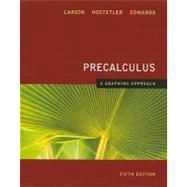
Note: Supplemental materials are not guaranteed with Rental or Used book purchases.
Purchase Benefits
What is included with this book?
| Prerequisites | |
| Real Numbers | |
| Exponents and Radicals | |
| Polynomials and Factoring | |
| Rational Expressions | |
| The Cartesian Plane | |
| Representing Data Graphically | |
| Functions and Their Graphs Introduction to Library of Parent Functions | |
| Graphs of Equations | |
| Lines in the Plane | |
| Functions | |
| Graphs of Functions | |
| Shifting, Reflection, and Stretching Graphs | |
| Combinations of Functions | |
| Inverse Functions | |
| Solving Equations and Inequalities | |
| Linear Equations and Problem Solving | |
| Solving Equations Graphically | |
| Complex Numbers | |
| Solving Quadratic Equations Algebraically | |
| Solving Other Types of Equations Algebraically | |
| Solving Inequalities Algebraically and Graphically | |
| Linear Models and Scatter Plots Cumulative Test: Chapters P-2 Progressive Summary: Chapters P-2 | |
| Polynomial and Rational Functions | |
| Quadratic Functions | |
| Polynomial Functions of Higher Degree | |
| Real Zeros of Polynomial Functions | |
| The Fundamental Theorem of Algebra | |
| Rational Functions and Asymptotes | |
| Graphs of Rational Functions | |
| Quadratic Models | |
| Exponential and Logarithmic Functions | |
| Exponential Functions and Their Graphs | |
| Logarithmic Functions and Their Graphs | |
| Properties of Logarithms | |
| Solving Exponential and Logarithmic Equations | |
| Exponential and Logarithmic Models | |
| Nonlinear Models Progressive Summary: Chapters P-4 | |
| Trigonometric Functions | |
| Angles and Their Measure | |
| Right Triangle Trigonometry | |
| Trigonometric Functions of Any Angle | |
| Graphs of Sine and Cosine Functions | |
| Graphs of Other Trigonometric Functions | |
| Inverse Trigonometric Functions | |
| Applications and Models | |
| Analytic Trigonometry | |
| Using Fundamental Identities | |
| Verifying Trigonometric Identities | |
| Solving Trigonometric Equations | |
| Sum and Difference Formulas | |
| Multiple-Angle and Product-to-Sum Formulas | |
| Additional Topics in Trigonometry | |
| Law of Sines | |
| Law of Cosines | |
| Vectors in the Plane | |
| Vectors and Dot Products | |
| Trigonometric Form of a Complex Number Cumulative Test: Chapters 5-7 Progressive Summary: Chapters P-7 | |
| Linear Systems and Matrices | |
| Solving Systems of Equations | |
| Systems of Linear Equations in Two Variables | |
| Multivariable Linear Systems | |
| Matrices and Systems of Equations | |
| Operations with Matrices | |
| The Inverse of a Square Matrix | |
| The Determinant of a Square Matrix | |
| Applications of Matrices and Determinants | |
| Sequences, Series, and Probability | |
| Sequences and Series | |
| Arithmetic Sequences and Partial Sums | |
| Geometric Sequences and Series | |
| Mathematical Induction | |
| The Binomial Theorem | |
| Counting Principals | |
| Probability | |
| Topics in Analytic Geometry | |
| Conics: Circles and Parabolas | |
| Conics: Ellipses | |
| Conics: Hyperbolas | |
| Parametric Equations | |
| Polar Coordinates | |
| Graphs of Polar Equations | |
| Polar Equations of Conics Cumulative Test: Chapters 8-10 Progressive Summary: Chapters P-10 | |
| Technology Support Guide | |
| Concepts in Statistics | |
| Measures of Central Tendency and Dispersion | |
| Least Squares Regression | |
| Variation | |
| Solving Linear Equations and Inequalities | |
| Systems of Inequalities | |
| Solving Systems of Inequalities | |
| Linear Programming | |
| Study Capsules | |
| Table of Contents provided by Publisher. All Rights Reserved. |
The New copy of this book will include any supplemental materials advertised. Please check the title of the book to determine if it should include any access cards, study guides, lab manuals, CDs, etc.
The Used, Rental and eBook copies of this book are not guaranteed to include any supplemental materials. Typically, only the book itself is included. This is true even if the title states it includes any access cards, study guides, lab manuals, CDs, etc.